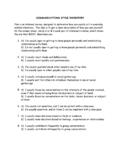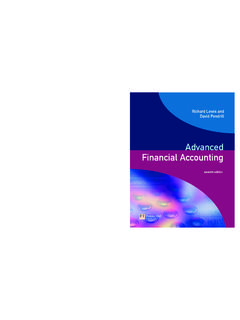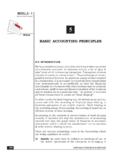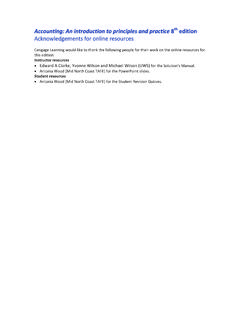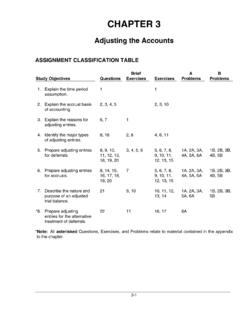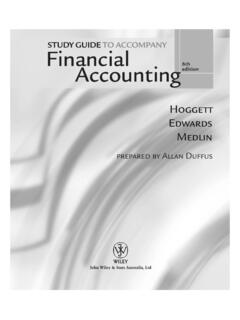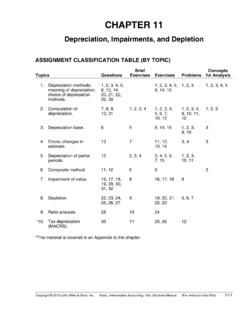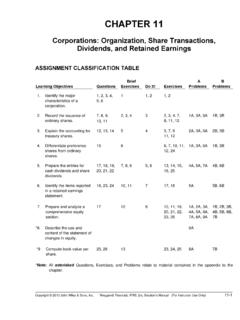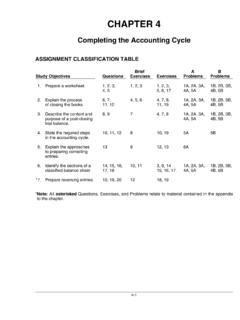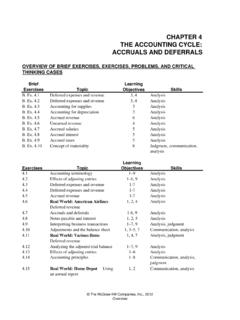Transcription of CHAPTER 16
1 16-1 CHAPTER 16 Dilutive Securities and Earnings Per ShareASSIGNMENT CLASSIFICATION TABLE (BY TOPIC)TopicsQuestionsBriefExercisesExerc isesProblemsConceptsfor Analysis debtand preferred , 2, 3, 4,5, 6, 71, 2, 31, 2, 3, 4,5, 6, 7, 8,23, 2421 and , 3, 8, 94, 57, 8, 9, 2611, 3 , 10, 11,12, 13, 14610, 11, 121, 32, 4 Per Share(EPS) , 22, 23,25136 Determiningpotentially , 18,19, 2010, 11, 1220, 21, 2545, 7 Treasury , 7 Weightedaverage , 168, 913, 14, 15,16, 194, 5, 6,7, 8, 9 , 135, 6, 7 , 18, 19,20, 21, 22,23, 24, 266, 7, 8 * stock,Stock , 1527, 28, 298*This material is dealt with in an Appendix to the CLASSIFICATION TABLE (BY LEARNING OBJECTIVE)Learning Objectives BriefExercisesExercisesProblems 1. Describe the accounting for the issuance,conversion, and retirement of , 22, 3, 4, 5, 61, 2 2. Explain the accounting for convertiblepreferred , 23 3. Contrast the accounting for stock warrants and forstock warrants issued with other , 51, 7, 8, 91 4.
2 Describe the accounting for stock compensationplans under generally accepted , 7, 810, 11, 121, 3 5. Discuss the controversy involving stockcompensation plans. 6. Compute earnings per share in a simplecapital structure9, 1313, 14, 15, 16,17, 18, 195, 8 7. Compute earnings per share in a complexcapital , 11, 1220, 21, 22, 23,24, 25, 264, 6, 7*8. Explain the accounting for various share-basedcompensation , 1527, 28, 29*9. Compute earnings per share ina complex CHARACTERISTICS TABLEItemDescriptionLevel ofDifficultyTime(minutes) E16-1 Issuance and conversion of 20 E16-2 Conversion of 20 E16-3 Conversion of 20 E16-4 Conversion of 20 E16-5 Conversion of 20 E16-6 Conversion of 35 E16-7 Issuance of bonds with stock 15 E16-8 Issuance of bonds with detachable 15 E16-9 Issuance of bonds with 20 E16-10 Issuance and exercise of stock 25 E16-11 Issuance, exercise, and termination of stock 25 E16-12 Issuance, exercise, and termination of stock 30 E16-13 Weighted average number of 25 E16-14 EPS: Simple capital 15 E16-15 EPS: Simple capital 15 E16-16 EPS: Simple capital 15 E16-17 EPS: Simple capital 25 E16-18 EPS: Simple capital 30 E16-19 EPS.
3 Simple capital 15 E16-20 EPS with convertible bonds, various 25 E16-21 EPS with convertible 20 E16-22 EPS with convertible bonds and preferred 25 E16-23 EPS with convertible bonds and preferred 15 E16-24 EPS with options, various 25 E16-25 EPS with contingent issuance 15 E16-26 EPS with 20 E16-27 accounting for restricted 15*E16-28 Stock appreciation 25*E16-29 Stock appreciation 25 P16-1 Entries for various dilutive 40 P16-2 Entries for conversion, amortization, and interest of 50 P16-3 Stock option 35 P16-4 EPS with complex capital 45 P16-5 Basic EPS: Two-year 35 P16-6 EPS computation of basic and diluted 45 P16-7 Computation of basic and diluted 35 P16-8 EPS with stock dividend and extraordinary 40 CA16-1 Warrants issued with bonds and convertible 25 CA16-2 Ethical issues compensation 20 CA16-3 Stock warrants various 20 CA16-4 Stock compensation 30 CA16-5 EPS: Preferred dividends, options, and convertible 30 CA16-6 EPS concepts and effect of transactions on 35 CA16-7 EPS, 35 CA16-8 Restricted stock and stock appreciation 3516-4 ANSWERS TO QUESTIONS such as convertible debt or stock options are dilutive because their features indicate thatthe holders of the securities can become common shareholders.
4 When the common shares areissued, there will be a reduction dilution in earnings per share. issue convertible securities for two reasons. One is to raise equity capital without givingup more ownership control than necessary. A second reason is to obtain common stock financing atcheaper rates. The conversion privilege attracts investors willing to accept a lower interest rate thanon a straight debt issue. debt and debt with stock warrants are similar in that: (1) both allow the issuer to issuedebt at a lower interest cost than would generally be available for nonconvertible debt; (2) both allowthe holders to purchase the issuer s stock at less than market value if the stock appreciatessufficiently in the future; (3) both provide the holder the protection of a debt security if the value of thestock does not appreciate; and (4) both are complex securities which contain elements of debt andequity at the time of debt and debt with stock warrants are different in that: (1) if the market price of the stockincreases sufficiently, the issuer can force conversion of convertible debt into common stock bycalling the issue for redemption, but the issuer cannot force exercise of the warrants.
5 2) convertibledebt may be essentially equity capital, whereas debt with stock warrants is debt with the additionalright to acquire equity; and (3) the conversion option and the convertible debt are inseparable and, inthe absence of separate transferability, do not have separate values established in the market;whereas debt with detachable stock warrants can be separated into debt and the right to purchasestock, each having separate values established by the transactions in the market. accounting treatment of the $160,000 sweetener to induce conversion of the bonds intocommon shares represents a departure from GAAP because the FASB views the transaction as theretirement of debt. Therefore, the FASB requires that the sweetener of $160,000 be reported as anexpense. It is not an extraordinary loss because it is simply a payment to induce conversion. 5.(a) From the point of view of the issuer, the conversion feature of convertible debt results in a lowercash interest cost than in the case of nonconvertible debt.
6 In addition, the issuer in planning itslong-range financing may view the convertible debt as a means of raising equity capital over thelong term. Thus, if the market value of the underlying common stock increases sufficiently afterthe issue of the debt, the issuer will usually be able to force conversion of the convertible debtinto common stock by calling the issue for redemption. Under the market conditions, the issuercan effectively eliminate the debt. On the other hand, if the market value of the commonstock does not increase sufficiently to result in the conversion of the debt, the issuer will havereceived the benefit of the cash proceeds to the scheduled maturity dates at a relatively lowcash interest cost.(b) The purchaser obtains an option to receive either the face amount of the debt upon maturity orthe specified number of common shares upon conversion. If the market value of the underlyingcommon stock increases above the conversion price, the purchaser (either through conversionor through holding the convertible debt containing the conversion option) receives the benefits ofappreciation.
7 On the other hand, should the value of the underlying company stock not increase,the purchaser could nevertheless expect to receive the principal and (lower) CHAPTER 16 (Continued) view that separate accounting recognition should be accorded the conversion feature ofconvertible debt is based on the premise that there is an economic value inherent in the conversionfeature or call on the common stock and that the value of this feature should be recognized foraccounting purposes by the issuer. It may be argued that the call is not significantly different in naturefrom the call contained in an option or warrant and its issue is thus a type of capital transaction. Thefact that the conversion feature coexists with certain senior security characteristics in a complexsecurity and cannot be physically separated from these elements or from the instrument does notconstitute a logical or compelling reason why the values of the various elements should not receiveseparate accounting recognition.
8 The fact that the eventual outcome of the option granted thepurchaser of the convertible debt cannot be determined at date of issuance is not relevant tothe question of effectively reflecting in the accounting records the various elements of the complexdocument at the date of issuance. The conversion feature has a value at date of issuance and shouldbe recognized. Moreover, the difficulties of implementation are not insurmountable and should not berelied upon to govern the conclusion. method used by the company to record the exchange of convertible debentures for commonstock can be supported on the grounds that when the company issued the convertible debentures,the proceeds could represent consideration received for the stock. Therefore, when conversionoccurs, the book value of the obligation is simply transferred to the stock exchanged for it.
9 Furtherjustification is that conversion represents a transaction with stockholders which should not give rise toa gain or the other hand, recording the issue of the common stock at the book value of the debentures isopen to question. It may be argued that the exchange of the stock for the debentures completesthe transaction cycle for the debentures and begins a new cycle for the stock. The consideration orvalue used for this new transaction cycle should then be the amount which would be received if thedebentures were sold rather than exchanged, or the amount which would be received if the relatedstock were sold, whichever is more clearly determinable at the time of the exchange. This methodrecognizes changes in values which have occurred and subordinates a consideration determined atthe time the debentures were issued. ,000,000 Discount on Bonds ,000 Bonds ,000,000 Paid-in Capital Stock ,000 Value of bonds with warrants$3,000,000 Value of warrants 200,000 Value of bonds without warrants$2,800,000In this case, the incremental method is used since no separate value is given for the bonds withoutthe warrants.
10 A corporation decides to issue new shares of stock, the old stockholders generally have the right,referred to as a stock right, to purchase newly issued shares in proportion to their holdings. No entryis required when rights are issued to existing stockholders. Only a memorandum entry is needed toindicate that the rights have been issued. If exercised, the corporation simply debits Cash for theproceeds received, credits Common Stock for the par value, and any difference is recorded witha credit to Paid-in Capital in Excess of SFAS No. 123(R), companies are required to use the fair value method to recognizecompensation cost. For most stock option plans compensation cost is measured at the grant dateand allocated to expense over the service period, which typically ends on the vesting CHAPTER 16 (Continued) plan would not be considered compensatory since it meets the conditions of a noncompensatoryplan; , (1) substantially all full-time employees may participate on an equitable basis, (2) thediscount from market price is small, and (3) the plan offers no substantive option profession recommends that the fair value of a stock option be determined on the date on whichthe option is granted to a specific the date the option is granted, the corporation foregoes the alternative of selling the shares at thethen prevailing price.


